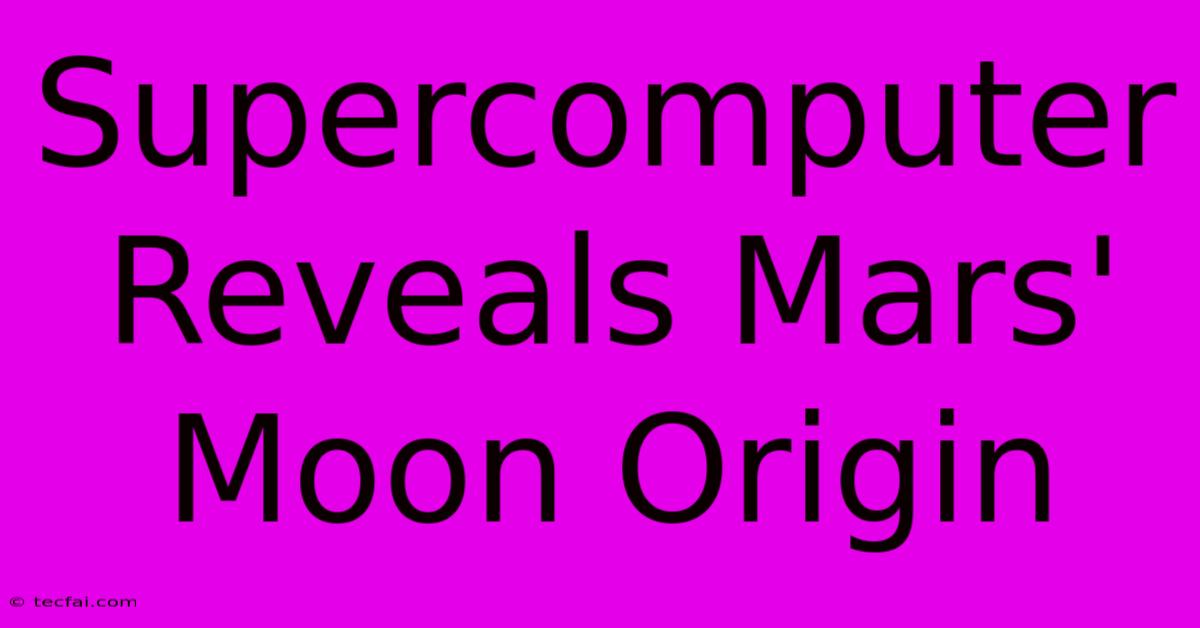Supercomputer Reveals Mars' Moon Origin

Discover more detailed and exciting information on our website. Click the link below to start your adventure: Visit Best Website tecfai.com. Don't miss out!
Table of Contents
Supercomputer Reveals Mars' Moon Origin: A Collision Course to Phobos and Deimos
For decades, the origin of Mars' two tiny moons, Phobos and Deimos, has remained a cosmic mystery. Were they captured asteroids, or did they form from the same primordial material as Mars itself? New research, leveraging the power of a supercomputer, points towards a compelling and dramatic answer: a colossal impact billions of years ago. This article delves into the groundbreaking findings, explaining the simulations and their implications for our understanding of the Martian system.
Unraveling the Martian Moon Mystery: A History of Theories
Before the advent of advanced supercomputer simulations, several hypotheses attempted to explain the existence of Phobos and Deimos. The most prominent theories included:
-
Capture Theory: This posited that Phobos and Deimos were asteroids gravitationally captured by Mars' weak gravitational pull. However, this theory struggled to explain the moons' remarkably circular orbits, which are unusual for captured objects.
-
Co-formation Theory: This suggested that Phobos and Deimos formed simultaneously with Mars from the same protoplanetary disk. But this hypothesis had trouble accounting for the moons' relatively small size and compositional differences compared to Mars.
The Supercomputer Simulation: A Giant Impact's Legacy
A team of researchers used a high-performance supercomputer to run incredibly detailed simulations of a giant impact on early Mars. These simulations modeled the conditions billions of years ago, accounting for factors like the velocity, angle, and size of the impacting body.
The results were astonishing. The simulations strongly suggest that a massive asteroid, perhaps tens of kilometers in diameter, collided with Mars. The debris ejected from this catastrophic collision coalesced over time, eventually forming Phobos and Deimos. This “giant-impact” scenario elegantly explains several previously unexplained observations:
Key Findings Supported by the Simulation:
-
Orbital Characteristics: The simulated debris field accurately predicted the nearly circular orbits of both moons.
-
Compositional Clues: The simulations helped explain the moons' porous, carbon-rich composition, which differs from Mars itself. This aligns with the idea that the moons formed from a mix of Martian material and the impacting body's material.
-
Moon Size Discrepancy: The simulations accurately replicated the significant size difference between Phobos and Deimos, revealing this to be a natural consequence of the chaotic nature of the post-impact debris cloud.
Implications and Future Research
This groundbreaking research significantly advances our understanding of the Martian system. By providing a plausible explanation for the origin of Phobos and Deimos, it also offers crucial insights into the early evolution of Mars and the processes that shaped its present-day environment.
This work, however, opens up new avenues of investigation. Future research could focus on:
- Refining the Simulations: More sophisticated simulations could incorporate more precise details of Martian geology and the composition of the impacting body.
- Observational Data: Future missions to Mars and its moons could provide crucial observational data to further validate or refine the giant-impact hypothesis. Close-up observations of Phobos' surface, for example, could reveal additional clues about its formation.
Conclusion: A New Chapter in Martian Exploration
The use of supercomputers to model planetary formation processes represents a significant leap forward in our ability to study the solar system. The findings regarding Mars’ moons showcase the power of computational astrophysics to reveal the secrets of our celestial neighborhood. The giant-impact scenario, supported by this new research, offers a compelling and likely explanation for the existence of Phobos and Deimos, bringing us closer to a comprehensive understanding of the fascinating history of the red planet. This is not just a story about two small moons; it's a story about the violent, dynamic past that shaped the solar system as we know it.

Thank you for visiting our website wich cover about Supercomputer Reveals Mars' Moon Origin. We hope the information provided has been useful to you. Feel free to contact us if you have any questions or need further assistance. See you next time and dont miss to bookmark.
Featured Posts
-
Severe Weather Alert Thanksgiving Storm
Nov 26, 2024
-
5 Ways To Explore Chess 2024
Nov 26, 2024
-
U Conns Win Streak Ends In Maui
Nov 26, 2024
-
Jon Benet Ramsey Netflix Doc Directors Regret
Nov 26, 2024
-
Tourist Boat Sinks Three British Dead
Nov 26, 2024
